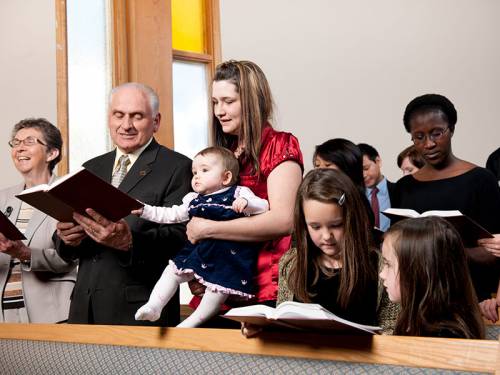One-room worship
By Sue Washburn | Presbyterians Today
 Growing up, one of my favorite shows was Little House on the Prairie. The characters were old and young, likable and unlikable. Even though some (like the Olesons!) were petty and others made mistakes, they were always there for each other when it counted. Little House had story lines for both kids and adults on the show.
Growing up, one of my favorite shows was Little House on the Prairie. The characters were old and young, likable and unlikable. Even though some (like the Olesons!) were petty and others made mistakes, they were always there for each other when it counted. Little House had story lines for both kids and adults on the show.
By contrast, today’s media programming is narrowly targeted. There are shows for preschoolers with fish and animals as characters. There are shows for elementary-age kids with teenagers as the heroes and adults as the fools. There’s Netflix and Hulu and iTunes for young adults to stream. And, of course, there are cable and network stations for generations of people who still use a TV set.
Gone are the days of a family gathering to watch the same screen and, with some exceptions, to watch shows that are intended for multiple generations. Today, dad and daughter can sit side by side while he watches a cooking show and she streams an animated movie — both wearing headphones.
Many churches have followed suit in their approach to worship. There’s children’s church with separate activities so the adults can actually listen to the sermon while their kids are off crafting and gaming in Jesus’ name. There are edgy services with “talks” instead of sermons, as well as traditional Sunday morning gatherings with robes and organs. Differentiation can be a good thing as we seek to reach new generations. But such targeting is beyond the reach of many small churches.
As I begin to plan for the “back-to-church” season, I’m remembering Little House on the Prairie’s one-room schoolhouse. Small churches are like that schoolhouse, bringing together people from all ages and backgrounds for one hour per week — farmhands, babies, grocery store owners, teenagers, retired professors, toddlers and the mayor can all show up.
No doubt, churches have always tried to reach everyone in the room with mass proclamation and discipleship. What’s new, though, is our hyper-segmented society. People expect to be catered to. This is a challenge for congregations who can’t afford a variety of programs. We have one, or at best two, hours of community time in which to proclaim, educate and inspire.
And so, as I get ready for fall, here are some things I’ll be trying:
Equal time. I realized one day that we expect kids to sit through an hour of adult worship but never expect adults to sit through more than a few minutes of child-centered worship. Yes, there are more adults in the room and there might be a brief children’s sermon to make us feel as if we are doing something for them, but for the most part the kids are neglected.
We sing hymns that require reading, sit still through sermons and even spend time in silence. What would change if we expected adults to participate in more child-appropriate worship? Perhaps opening with a kid-friendly hymn (“Jesus Loves Me” or “This Little Light of Mine”) and doing motions?
Intentional illustration. Multiple ages mean multiple frames of reference. Just as one-room schoolhouse teachers didn’t try to teach kindergartners multiplication, we pastors shouldn’t speak one way and assume everyone will get it. A sermon illustration from a trusted commentary can be woefully outdated to a 28-year-old, while one referencing something online will be confusing to an 80-year-old. Bubble Guppies and Captain Kangaroo can be meaningful or meaningless, depending on the age. What if we tried to reach all ages by being intentional and varied with our illustrations? Can we take the object lesson out of the kids’ time and into the sermon?
Confidence in the crowd. If you are like me, you probably feel as if you can’t reach every person every week, no matter how hard you try. The good news is that you don’t have to. Intergenerational worship means grandparents and parents can talk to the kids, or the teens can enlighten the parents, because they were all in the same space, singing the same songs and hearing the same Scriptures.
With the intergenerational experience, we don’t have to ask what they did at church in the car ride home. We already know because we were being the church together.
Sue Washburn is the pastor of Reunion Presbyterian Church in Mount Pleasant, Pennsylvania, and a freelance writer. She keeps a few jars of emergency Play-Doh behind the pulpit to illustrate difficult theological concepts.
![]() You may freely reuse and distribute this article in its entirety for non-commercial purposes in any medium. Please include author attribution, photography credits, and a link to the original article. This work is licensed under a Creative Commons Attribution-NonCommercial-NoDeratives 4.0 International License.
You may freely reuse and distribute this article in its entirety for non-commercial purposes in any medium. Please include author attribution, photography credits, and a link to the original article. This work is licensed under a Creative Commons Attribution-NonCommercial-NoDeratives 4.0 International License.
Categories: Presbyterians Today, Youth
Tags: children, intergenerational, worship
Ministries: Presbyterians Today, Worship, Youth Ministry